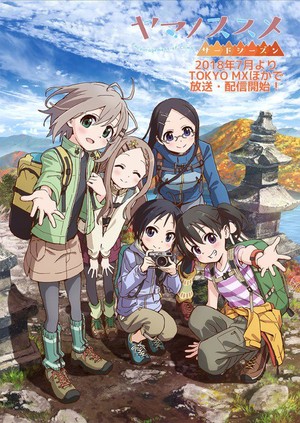Interest
Encouragement of Climb Director Discusses Pros, Cons of Using Real-life Reference Photos in Anime
posted on by Kim Morrissy
 In an interview published in Anime Style Issue #14, Encouragement of Climb director Yūsuke Yamamoto and chief animation director Yuusuke Matsuo discussed the pros and cons of using real-life reference photos in anime. They said that the goal of the animation is to make the viewer feel as if they are climbing mountains alongside the characters. In order for that to get across, the staff climbed the mountains depicted in the anime, and Yamamoto himself took many photos as reference.
In an interview published in Anime Style Issue #14, Encouragement of Climb director Yūsuke Yamamoto and chief animation director Yuusuke Matsuo discussed the pros and cons of using real-life reference photos in anime. They said that the goal of the animation is to make the viewer feel as if they are climbing mountains alongside the characters. In order for that to get across, the staff climbed the mountains depicted in the anime, and Yamamoto himself took many photos as reference.
"In this day and age, we have things like Street View and Google Earth, so you can easily obtain footage of, say, Mt. Takao from the sky. But if I used that, it wouldn't be Encouragement of Climb. By going there myself and taking photos at the height as I observe them, Aoi's point of view comes more naturally to me when I put the photos in chronological order and draw the storyboards."
Yamamoto explained that when constructing layouts, you have to put yourself into the shoes of the characters. He said that with Encouragement of Climb, he went for long shots and close ups to make it feel more intimate, and avoided using aerial shots because it would put distance between the viewers and the characters. He said that by the time they were working on the second season, the staff more or less understood Yamamoto's approach and would draw storyboards that way without needing to be told.
However, Yamamoto pointed out the difference between taking the photos yourself and using photos taken by others as reference. It's not standard practice to replicate every single detail in a photo in a storyboard or layout, therefore even a drawing that closely follows a reference photo will crop the image. If the artist hasn't been to the location themselves, then their cropping may result in the image not properly conveying the atmosphere of the location. "Since I've been to the location and know it best, there are many times when I sheepishly correct the other artists' work," Yamamoto said.
For the production of Encouragement of Climb, Yamamoto attached reference photos to the storyboards and passed them to the background art staff and the animation directors. This saves time because he doesn't have to draw the main features shown in the photo himself. However, his approach is not necessarily standard in the industry and was frowned upon in earlier times. "When I started out as a director, I was often told, 'It's heresy to stick photos onto the storyboards.'"
On the other hand, although not every photo can easily translate to anime, Encouragement of Climb has a film-like approach to cinematography, so a number of photos can be translated directly to anime after they have been edited to fit a 16:9 screen. There are still problems for the background art staff to deal with, like what level of detail should be replicated in the anime and where the focus of the shot should be, but the background art staff has gradually become more accustomed to dealing with photos.
"When we were starting work on the first season, the background art staff told me to stop using photos as layouts because they wanted to draw their own pictures instead of relying too much on photos. So I used the photos as reference and did all the layouts by hand. It's because the first season was a short anime that we had the time available to do that. But with the second season, the staff changed, and the industry itself had moved to the point where photos are seen as valid."
Part of the change was inspired by the need to introduce time-saving measures. Matsuo mentioned that there are times when he doesn't bother drawing out blueprints for a shot at all and just sends everyone reference photos instead. Nevertheless, large chunks of Encouragement of Climb's layouts are still drawn by hand. Yamamoto mentioned that Matsuo drew all the layouts for the first half of the Encouragement of Climb: Gift of Memories OAV by hand. It's not easy to accomplish because photos guarantee a certain level of realism, but Yamamoto hopes that it had a positive effect on the anime.
In some cases, the realism provided by photos is a downside. There were cases in the third season where the staff did retakes of shots in order to make them more picturesque instead of photo-realistic. "If I replicate a photo as-is, it somehow comes across as lacking. In the pre-digital era, everyone was impressed with photo-like backgrounds, but these days, they'd be like, 'Oh, it's just a photo,' and leave it at that, even though it's not actually a photo. That's the context in which Matsuo lent his efforts towards making it look closer to a picture, even though he's an animator [and not a background artist]."
Matsuo remarked that creating animation is all about controlling the level of detail presented onscreen. Reference photos present a "finished answer", and from there the staff decides what to take or remove. Yamamoto concluded by saying that he doesn't aspire towards incorporating a high level of detail in the anime, but rather that he wants to capture comfort and a sense of warmth through the artwork. "I think that the first season handled that balance the best," he said.
Source: Anime Style Issue #14 (February 2019)